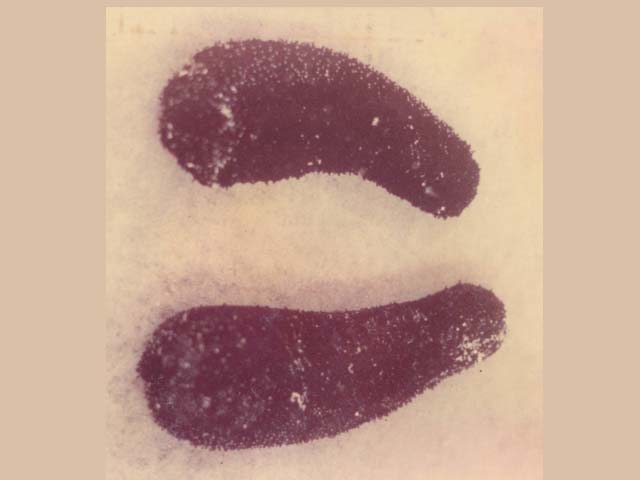| Holothuriidae (sea cucumbers) |
| 60 cm TL (male/unsexed); max.weight: 1,000.0 g |
|
benthic; marine; depth range 0 - 30 m |
| Indo-Pacific. |
|
Body Width: 10 cm. Body Thickness: 0.8 cm. Mean live weight about 200 g to 1000 g; body thickness about 4 mm. Body: cylindrical, elongate, with rounded ends. Tegument smooth, often covered by sand, but also showing round patches lacking sand. A red toxic fluid is secreted upon rubbing the body surface vigorously. Podia on bivium sparsely distributed, ending in a small disc around 150 micrometer in diameter; podia on trivium numerous, short and stout, distributed on the radii and the interradii, their calcareous disc around 0.05 cm in diameter. Mouth: ventral, surrounded by 20 black tentacles. Anus terminal. Calcareous ring with large radial pieces and narrow interradials. Cuvierian tubules absent. Color: entirely black. Spicules: tegument with tables and rosettes; tables with circular disc showing 8 holes (4 central and 4 smaller holes in between) and s spire of 4 pillars, ending in maltese crown; rosettes small and simple, more abundant in ventral tegument; ventral podia without rods, but with pseudo-plates; dorsal podia and papillae with short rods, showing denticulate borders. |
| The mean population density is around 0.5 per square meter, but can exceed 4 per square meter. Traditionally harvested, but the processed product is of low commercial value. In recent times, due to increasing demand, this species also appears in the processed products of many Pacific Islands. Collected by hand at low tide while wading on the reefs, or by divers (Ref. 122). Processed to trepang in Puerto Princesa, Palawan (Ref. 543). A common shallow-water species, rarely found at depths of more than 20 m, mostly on inner and outer reef flats and back reefs or shallow coastal lagoons; abundant on sandy-muddy grounds with rubble or coral patches and in seagrass beds (Ref. 122). Intertidal. Also found on coarse and fine sandy areas in coral communities (Ref. 129602). Body is often almost completely covered by sand grains (Ref. 102838). The mean population density is about 0.5/square meter, but can exceed 4/square meter. Inshore shallow-water populations are denser, composed of smaller individuals, while deeper or outer reef populations, individuals are more scattered and with larger sizes (Ref. 122). Feeds on Halimeda sp. (Ref. 118). Known to release a wine-colored exudate when rubbed vigorously (Ref. 85218). |
|
(LC); Date assessed: 18 May 2010 Ref. 123251)
|
|
|
Source and more info: www.sealifebase.org. For personal, classroom, and other internal use only. Not for publication.

